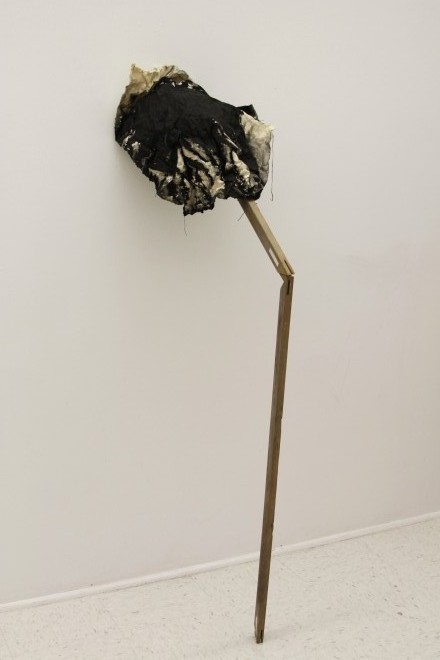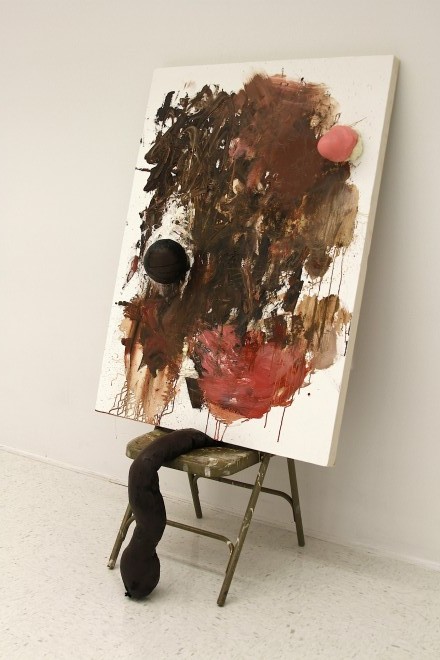Having just completed his BFA from SAIC this past spring, and getting accepted into the graduate program at Northwestern this past fall, I had the chance to speak with Danny Giles about his recent work.
Recalling the same sort of reliance on space as the work being currently exhibited in the ‘Elemental Structures’ portion of The Language of Less: Then and Now at the MCA, Giles’ paintings lean in a way that is dependent on their surroundings, but far from weak. Drawing attention to the painting support in a variety of ways, such as the ability to balance itself against the wall in “lean-to,” or through the unfamiliarity of what material additions adhere to the surface in “da-da-duh,” the appendages in Giles’ paintings allow the possibility to be read as all things, declaring none.
Stephanie Cristello: How has the transition to grad school been? What are some of the differences, challenges and benefits between Northwestern MFA and the BFA at SAIC?
Danny Giles: I wouldn’t really compare the BFA experience at SAIC to the graduate program at NU. Both have very unique qualities are really two very different things. For the most part, I had a great time at SAIC. I moved around the school and through different departments quite a lot and got to work with many great teachers. Taking classes in sculpture and print media gave me more nuanced ways of dealing with art outside of painting discourse. The Advanced Painting program was especially important — it’s the closest thing to a graduate school setting available to an undergrad, and you really get to learn how to be part of a critical community.
It has been great transitioning into a much smaller community within such a large research institution. In a way, it feels less institutional at NU, working apart from the main campus with a handful of other students in a decrepit old house. It’s challenging but great to be working with the same small group of folks and really getting to know them and the work. Also, working within one small department within an entire school of Humanities reminds you that art is not necessarily the end-all be-all.
SC: I’m interested in how your recent work seems to have taken a more sculptural turn, perhaps more in line with the hair-extension piece you showed at the BFA exhibition last March. “Lean-to” carries that same sort of verticality and relationship to the body — can you talk a bit about your material choices in regard to the newer work?
DG: I have always had sculptural tendencies, even though most of the things I make could be called ‘painting’. I’ve been interested for some time in addressing the object qualities of my pictures and also looking for sculptural approaches to addressing issues of painting. With my current work, I am really thinking about ways of addressing painting as a body as well as representing and addressing multiple other bodies. This has taken me to the point that I am working with ways of articulating the painting’s relationship with literal space.
SC: What are some of those ‘multiple other bodies’? Are you talking about ‘the body’ as a framework, a specific reliance to the space it occupies, or both?
DG: I’ve spent a lot of time thinking about my work as it relates to notions of identity. This has led to a particular fixation on the body. I’m interested in the body as it relates to systems of power, which impose conventions on identity. I look at the painting as a body that is formed both through various tropes and conventions as well as the projection of my own subjectivities. The studio space is a space where psychosocial conditions are channeled through me and manifest in the finished work. As the artist, I am both the ‘master’ of the painting, as well as the subject depicted. I participate in the fabrication of the identity of the work through the different gestures I employ and the conventions and tropes of painting and sculpture provide me with a language for investigating issues of race and masculinity. Bringing my paintings into more literal object-space I’m creating a space for the viewer’s body to be implicated within the viewing of a work as well.
SC: The appendages to the paintings, especially in “da-da-duh,” appear to be a direct reference to Ofili — who are some of the artists you are currently looking at?
DG: Ofili is great — there are some significant ways in which our works relate, but I don’t like to talk about my work as being homage to any one artist. There is a very different charge in Ofili’s paintings with elephant dung. It’s a literal material with very immediate and concrete cultural meanings. The appendages that often adorn my paintings might sometimes look like shit, but I think there are a number of referents available in their ambiguity. The objects attached to “da-da-duh” could read as a variety of forms.
SC: I agree, there is a definitely a level of ambiguity that spans your work, in that any number of associations appear to be welcomed by the audience. The pieces present themselves in sort of an unassuming way — the possibility to be read as all things, but declaring none. Is this something you’re pursuing in your other work or have in the past?
DG: Definitely. I have always been wary of my work becoming too pedagogical. In the past, I had found it reaching the point where the content pushing the execution would be too clear and allow people to dismiss it without having to grapple with their own interpretations and hang-ups. The longer I can suspend the moment at which the viewer forms a complete and settled understanding of what it’s all about, the more likely they are to have some more complex and problematic understanding of what I’m doing. Propaganda and advertising often work the other way, where you know exactly what’s being pushed on you, but since the delivery is so familiar and seductive, you either want to be manipulated by it or you refuse it outright. Marketers seem to be catching on lately, that you can get someone to stick around for your message if you delay the moment of recognition. You could look at my work in this way of a delaying recognition. Different aspects of the works have different speeds of delay, so I can keep the identities of the works unsettled and problematic.
SC: Do you see yourself staying in Chicago after MFA?
DG: Right now I’m really excited about Chicago. I see a lot of good energy everywhere and I definitely want to be a part of that, but I think it’s important to be able to be mobile and to be present where opportunity arises. Chicago has so far been a great place to learn about art and form friendships with some really smart and talented people, but it’s definitely not the only place to do that.

























[…] Danny Giles […]